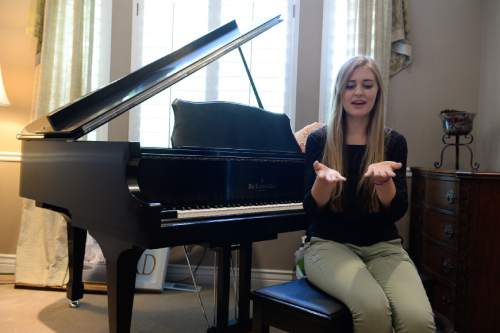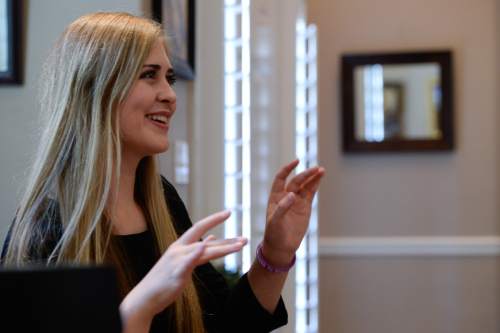This is an archived article that was published on sltrib.com in 2015, and information in the article may be outdated. It is provided only for personal research purposes and may not be reprinted.
Cedar Hills • When Hailey Bennett was a little girl, her parents joked that at least there was one thing to keep their precocious, thick-lashed child humble — cold, sweaty hands.
"They were just gross hands, to be honest," says Jeanette Bennett.
By the time Hailey was a teenager, and had been acting in community and school theater for years, it wasn't a joke anymore.
On stage, she would wipe her hands on her thighs before touching other actors. Every pair of pants, skirt and dress fabric had to pass the test: Could it absorb moisture without it showing?
Jeanette and Matt Bennett helped Hailey try most of what's on the market to stop the sweating — baking soda, prescription-grade antiperspirants, electrolysis. She stopped short of Botox injections, which must be repeated. None of the rest of the treatments worked.
Finally, they got a diagnosis for her sweaty hands — hyperhidrosis — and a doctor who could help, cardiothoracic surgeon John Mitchell at Utah Valley Regional Medical Center.
Last December, Hailey was sedated and Mitchell snipped away pieces of a nerve on both sides of her chest, leaving three small incisions on each side.
The surgery, called a surgical sympathectomy, is not a fancy operation, says Mitchell. Hailey went home the same day. The teen could tell, even as she was in the recovery room, that it had worked. "I woke up … and started crying and the nurse was making me drink water and I was hugging her and saying 'Thank you!'" she recalls. "It was instant."
She no longer sweats from her armpits, either, but she does sweat through other pores.
An estimated 1 percent of the population has hyperhidrosis, but it often goes undiagnosed, Mitchell says.
"People don't recognize it as a treatable medical problem. They just think they have sweaty hands," he says. "You never go into a screening exam where you're asked, 'Do you have sweaty hands?' It's never brought up."
The condition typically shows up at puberty, although it's not directly connected. That's when sweat glands develop, Mitchell says.
Many people suffer sweaty armpits and feet as well as hands, and the surgery can work for them as well.
It's not an issue of heat intolerance, he says. "People will sweat in the dead of winter, when it's cold."
With some people who have hyperhidrosis, you can see the sweat drip from their fingertips. "I've had people, if you hold a cup and their hands above, they'll fill the cup with water."
Insurance companies typically will pay for the surgery, as long as the patient has exhausted other treatments like using prescription antiperspirants.
For Hailey, the sweating began much earlier than puberty. She remembers being unable to cross the monkey bars as a child because her wet hands would slip. The sweating got worse as she became a teenager, and so did the embarrassment.
"It wasn't clammy hands. It was sweat," she says. "Boys are a thing now. I thought, 'This isn't cute anymore.'"
For her mother, it was particularly hard to watch Hailey surreptitiously wipe her hands while on stage.
"I realized this was on her mind all the time and that made me sad as a mom," she says.
Hailey, 15, starts her high school career at Lone Peak High School on Wednesday.
For the first time, she'll start a school year unworried about soaking sheets of paper as she takes notes or a test, about touching new friends and fearing embarrassment. And this fall, when she plays the part of Belle in the Hale Centre Theatre's junior production of Beauty and the Beast, she won't be wiping her hands at every turn.
She marvels now a surgery she feared helped her so much. "I'd do it again in a heartbeat."













